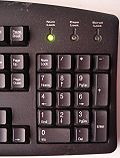Blender 3D: Noob to Pro/Keystroke, Button, and Menu Notation
As you read through these tutorials, you will encounter cryptic codes such as SHIFT + LMB and Timeline → End Frame. They describe actions you perform using the keyboard and mouse. The notation used in this book comes from the standard used by the Blender community. We will try to import those standards here to facilitate our studies.
If you're reading this book online, you may wish to print this page for future reference. In addition, or as an alternative, you can bookmark it in your browser for faster reference.
Hotkeys
[edit | edit source]
Most computer keyboards have number keys in two different places. A row above the letters, and in a numpad (numeric keypad) to the right of the keyboard. While many applications use these two sets of keys interchangeably, Blender does not. It assigns different functions to each set. If you're using a laptop keyboard without a separate numeric keypad, this might cause some difficulty. You'll need to use your function key to do some things. It is possible to indicate to Blender the type of keyboard you are using, but we strongly recommend you use a standard external keyboard if you use a laptop for these tutorials as it will make your studies and usage of Blender much more straightforward and enjoyable.
This book often assumes your keyboard has a numpad. If yours doesn't, consult the tutorial on Non-standard Input Devices for alternative ways to access the numpad's functions.
Key Notation
[edit | edit source]| Notation | Corresponding key or action |
|---|---|
| Alt | The Alt key (known as ⌥ Option on Apple keyboards) |
| Cmd | The ⌘ Command key also known on other platforms as the ⌘ Windows key or ❖ Super key |
| Ctrl | The ⌃ Ctrl key (also known as the Control key) |
| Fn | The Fn key (also known as the Function key, generally found only on laptops) |
| Shift | The ⇪ Shift key |
| Enter | The ↵ Return key (also known as the Enter key) |
| Esc | The Esc key (also known as the Escape key) |
| F1 through F12 | The function keys F1 through F12 (often in a row along the top of the keyboard) |
| Space | The Spacebar |
| Tab | The ↹ Tab key |
| A through Z | The letters A to Z (on the keyboard) |
| 0key through 9Key | The digits 0 to 9, placed above the letters on the keyboard |
| Num0 through Num9 | The digits 0 to 9, placed on the numpad |
| NumLock , Num/ , Num* , NUM− , Num+ , NumEnter , and Num. | The NumLock, /, *, -, +, Enter, and . keys respectively, all located on the numpad. |
| Delete | The Delete key |
| Down Arrow | The ⇣ Down Arrow key |
| Left Arrow | The ⇠ Left Arrow key |
| Right Arrow | The ⇢ Right Arrow key |
| Up Arrow | The ⇡ Up Arrow key |
When a key is used in a module, it means press that key. For exammple:
- M means "press the M key"
- Num0 means "press the 0 key thats found on the numpad."
Combinations that involve holding down a key while performing another action are written with a plus sign (+). For example:
- Shift + Tab means "press Tab while holding down Shift "
- Shift + Ctrl + F9 means "press F9 while holding down both Ctrl and Shift "
Mouse Notation
[edit | edit source]Blender uses three mouse buttons and the scroll wheel, if you have one. If your mouse only has one or two buttons, consult the tutorial on Non-standard Input Devices for alternative ways to access the functions assigned to these buttons.
| Notation | Corresponding action |
|---|---|
| LMB | click with the Left Mouse Button |
| RMB | click with the Right Mouse Button |
| MMB | press down on (don't turn) the scroll wheel or Middle Mouse Button |
| SCROLL | turn the scroll wheel in either direction |
Mouse and keyboard actions are often combined. Shift + RMB means to click RMB while holding down Shift .
Navigating Menus
[edit | edit source]Blender uses both pop-up and pull-down/pull-up menus. Many menus have sub menus (menus that are reached via another menu). If a menu item displays a triangle, that means it leads to a sub menu.

You can move through items in a menu by either:
- Moving the mouse pointer up and down
- Pressing Up Arrow and Down Arrow
You can enter a sub menu by either:
- Moving the mouse pointer to the right
- Pressing Right Arrow while hovering over a menu item that shows a triangle on its side.
You can leave a sub menu by doing one of the following:
- moving the mouse pointer to the left
- pressing Left Arrow
To initiate a menu action, you can:
- click LMB
- press Enter
You can escape from a menu by:
- moving the mouse pointer away from the menu
- pressing Esc
For each menu, Blender remembers your last choice and highlights it for you the next time you enter the menu.
Notation
[edit | edit source]Menu notation is fairly self-explanatory.
Shift + A Mesh → UV Sphere
Means:
- Press Shift+A
- In the menu that pops up, move through the items until Mesh is highlighted
- Enter the Mesh sub menu
- Move through the items until UV Sphere is highlighted
- Press Enter or click the left mouse button to initiate the action
Additional Resources
[edit | edit source]- the Blender Manual page on "keyboard and mouse" at http://wiki.blender.org/index.php/Doc:Manual/Interface/Keyboard_and_Mouse
